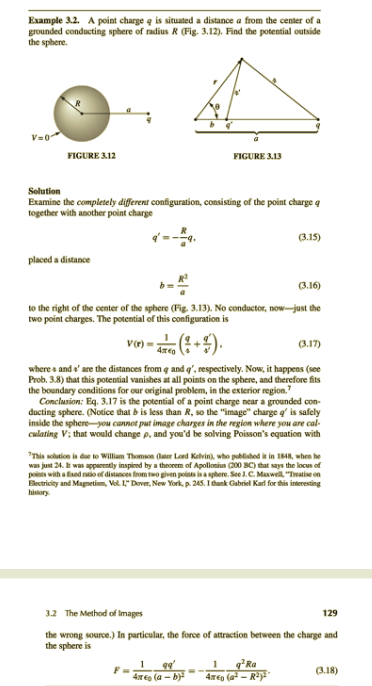Problem 3.9 In Ex. 3.2 we assumed that the conducting sphere was grounded (V = 0). But with the addition of a second image charge, the same basic model will handle the case of a sphere at any potential Vo (relative, of course, to infin- ity). What charge should you use, and where should you put it? Find the force of attraction between a point charge q and a neutral conducting sphere.
Problem 3.9 In Ex. 3.2 we assumed that the conducting sphere was grounded (V = 0). But with the addition of a second image charge, the same basic model will handle the case of a sphere at any potential Vo (relative, of course, to infin- ity). What charge should you use, and where should you put it? Find the force of attraction between a point charge q and a neutral conducting sphere.
Introductory Circuit Analysis (13th Edition)
13th Edition
ISBN:9780133923605
Author:Robert L. Boylestad
Publisher:Robert L. Boylestad
Chapter1: Introduction
Section: Chapter Questions
Problem 1P: Visit your local library (at school or home) and describe the extent to which it provides literature...
Related questions
Question

Transcribed Image Text:Example 3.2. A point charge q is situated a distance a from the center of a
grounded conducting sphere of radius R (Fig. 3.12). Find the potential outside
the sphere.
V=0
FIGURE 312
FIGURE 3.13
Solution
Examine the completely different configuration, consisting of the point charge q
together with another point charge
--.
(3.15)
placed a distance
(3.16)
to the right of the center of the sphere (Fig. 3.13). No conductor, now-just the
two point charges. The potential of this configuration is
Vr) =
(3.17)
where s and e' are the distances from q and q', respectively. Now, it happens (see
Prob. 3.8) that this potential vanishes at all points on the sphere, and therefore fits
the boundary conditions for our original problem, in the exterior region."
Conclusion: Eq. 3.17 is the potential of a point charge near a grounded con-
ducting sphere. (Notice that b is less than R, so the "image" charge q' is safely
inside the sphere-you cannot put image charges in the region where you are cal-
culating V; that would change p, and you'd be solving Poisson's equation with
"Tis solution is due to William Thomson (later Loed Kelvin), who published ik in 1848, when he
was just 24. It was apparently inspired by a theorem of Apollonius (200 BC) that says the locus of
points with a fed ratio ef distances from two given points is a spbere. See .C. Maswell "Treatise on
Electricity and Magnetism, Vel. 1," Dover, New York, p. 245. I thank Gabriel Karl for this interesting
history.
3.2 The Method of Images
129
the wrong source.) In particular, the force of attraction between the charge and
the sphere is
q*Ra
4xeo (a - Ra
1
(3.18)
4T€0 (a - b)
![Problem 3.9 In Ex. 3.2 we assumed that the conducting sphere was grounded
(V = 0). But with the addition of a second image charge, the same basic model
will handle the case of a sphere at any potential Vo (relative, of course, to infin-
ity). What charge should you use, and where should you put it? Find the force of
attraction between a point charge q and a neutral conducting sphere.
Chapter 3 Potentials
!
Problem 3.10 A uniform line charge à is placed on an infinite straight wire, a dis-
tance d above a grounded conducting plane. (Let's say the wire runs parallel to the
x-axis and directly above it, and the conducting plane is the xy plane.)
(a) Find the potential in the region above the plane. [Hint: Refer to Prob. 2.52.]
(b) Find the charge density o induced on the conducting plane.](/v2/_next/image?url=https%3A%2F%2Fcontent.bartleby.com%2Fqna-images%2Fquestion%2F59ac16da-d4e3-4ce0-9d74-dd9cf308c065%2Fb465e131-699c-4dca-8063-fa9a6e8cc2f0%2Fccslmil_processed.png&w=3840&q=75)
Transcribed Image Text:Problem 3.9 In Ex. 3.2 we assumed that the conducting sphere was grounded
(V = 0). But with the addition of a second image charge, the same basic model
will handle the case of a sphere at any potential Vo (relative, of course, to infin-
ity). What charge should you use, and where should you put it? Find the force of
attraction between a point charge q and a neutral conducting sphere.
Chapter 3 Potentials
!
Problem 3.10 A uniform line charge à is placed on an infinite straight wire, a dis-
tance d above a grounded conducting plane. (Let's say the wire runs parallel to the
x-axis and directly above it, and the conducting plane is the xy plane.)
(a) Find the potential in the region above the plane. [Hint: Refer to Prob. 2.52.]
(b) Find the charge density o induced on the conducting plane.
Expert Solution
This question has been solved!
Explore an expertly crafted, step-by-step solution for a thorough understanding of key concepts.
This is a popular solution!
Trending now
This is a popular solution!
Step by step
Solved in 5 steps with 1 images

Knowledge Booster
Learn more about
Need a deep-dive on the concept behind this application? Look no further. Learn more about this topic, electrical-engineering and related others by exploring similar questions and additional content below.Recommended textbooks for you

Introductory Circuit Analysis (13th Edition)
Electrical Engineering
ISBN:
9780133923605
Author:
Robert L. Boylestad
Publisher:
PEARSON

Delmar's Standard Textbook Of Electricity
Electrical Engineering
ISBN:
9781337900348
Author:
Stephen L. Herman
Publisher:
Cengage Learning

Programmable Logic Controllers
Electrical Engineering
ISBN:
9780073373843
Author:
Frank D. Petruzella
Publisher:
McGraw-Hill Education

Introductory Circuit Analysis (13th Edition)
Electrical Engineering
ISBN:
9780133923605
Author:
Robert L. Boylestad
Publisher:
PEARSON

Delmar's Standard Textbook Of Electricity
Electrical Engineering
ISBN:
9781337900348
Author:
Stephen L. Herman
Publisher:
Cengage Learning

Programmable Logic Controllers
Electrical Engineering
ISBN:
9780073373843
Author:
Frank D. Petruzella
Publisher:
McGraw-Hill Education

Fundamentals of Electric Circuits
Electrical Engineering
ISBN:
9780078028229
Author:
Charles K Alexander, Matthew Sadiku
Publisher:
McGraw-Hill Education

Electric Circuits. (11th Edition)
Electrical Engineering
ISBN:
9780134746968
Author:
James W. Nilsson, Susan Riedel
Publisher:
PEARSON

Engineering Electromagnetics
Electrical Engineering
ISBN:
9780078028151
Author:
Hayt, William H. (william Hart), Jr, BUCK, John A.
Publisher:
Mcgraw-hill Education,